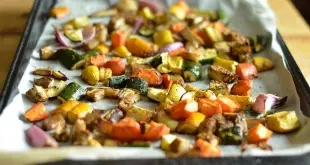Oh, this is where the fun begins. For everything you wanted to know about carbs (well, maybe not everything) check out the BF Basics series, Carb Confusion. But here are the basics of carbs on the nutrition label.
The total carbohydrates are all the carbs in the product. This includes the fiber, the sugars and the “other carbohydrates” (usually sugar alcohols). But under that there are a few sub-categories. Let’s go through them.
Fiber
Adults should strive for 25g of fiber a day, so this number is important. But a food should NOT be discounted because of low fiber. Recognize that some foods are never going to have high fiber. Meat, for instance. Meat is mainly a source of protein and therefore would not have a sufficient enough amount of carbohydrates to have good fiber.
One important thing, in my view, is to be wary of foods with really small serving sizes and a lot of fiber. How’d they get all that fiber in that little bit of food? Our bodies can’t break down fiber, which is why it doesn’t count in the “net carb” count of a food. But it does help scrub out our innards, which is good. Unfortunately the very thing that makes fiber good for our bodies makes it an unpleasant thing to eat. It’s tough to chew and makes other things really dense. So if you come across a small portion with high fiber, you might proceed with caution. I’m just sayin’.
You might also notice there are two types of fiber: Soluble and insoluble fiber.
- Soluble fiber (oats, beans, legumes, fruits, veggies), when mixed with water, forms a gel-like substance that swells. That helps us regulate glucose and cholesterol levels.
- Insoluble fiber (bulghur, quinoa) do not absorb water at all. To be blunt, these help us poo.
One note I make in Carb Confusion that bears repeating: Fiber is a carbohydrate, therefore you cannot get fiber without eating carbohydrates. And since you need fiber, it stands to reason that you need carbohydrates!
The best way to get fiber is to choose whole grain foods. Not to sound over simplistic, but a whole grain food uses the whole grain: the bran, the endosperm, the fiber. It’s all in there. Whole grain foods are highest in fiber. DON’T, however, be swayed by claims on food packaging that advertise that they provide your complete daily value of whole grains. This is not the same as being high fiber. Read the label!
Sugars
Not to seem like I’m conducting shameless self promotion, but I also have a series on sugar content. Check it out to learn more than you ever wanted to know about sugar content. Again, here are the basics.
- Just because something has sugar listed does NOT mean it is bad! Fructose and lactose (fruit and milk sugars respectively) are both listed in the sugar category
- If something says sugar-free, however, there should be no sugar listed
- If something says no-sugar added, that means no sugar was added, but sugar in the source food may be present. So don’t flip if you see a sugar count listed. If that count is high, you need to think about whether you should be eating that food or not.
Other Carbohydrates
Those are usually sugar alcohols. Sugar alcohols are used to sweeten some things, but since our bodies can’t absorb them, they don’t count as sugars. They do, however, have an effect on your body. Foods high in sugar alcohols can produce painful gas, bloating and even unpleasant bathroom experiences.
Like the trans fat we talked about the other day, high sugar alcohol levels are commonly found in foods we should have in our “extreme moderation” column. Sugar-free cookies, ice cream and the like can all have high sugar alcohol levels.
Splenda, or sucralose, is NOT a sugar alcohol. Say what you want about it, but it’s not. Sugar alcohols end in…what else? “ol!” Manitol, Sorbital, Erythritol…these are all sugar alchohols. Be warned!
We’re coming into the home stretch, peeps! Are you feeling more educated and empowered! I haven’t heard a peep from any of you about this series so far. If you’re learning stuff, let me know! It’s the only way I know what to do more of!
Tomorrow, we talk about everyone’s favorite macro-nutrient: protein!
 Bariatric Foodie Play with your food
Bariatric Foodie Play with your food



This site was just recommended to me today by someone from OH. I gotta say your site has some valuable information especially for me recently coming out of WLS. I'd give ya a thumbs up! 🙂
Thanks Diana! Glad to hear the word is spreading! I hope you find many good recipes and much good information here.
I am a preop and am already in love with this site!! thank u for all this fab info!!